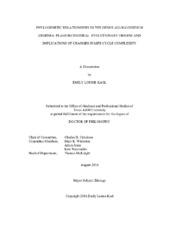| dc.description.abstract | Parasite life cycle complexity (host species and number needed to complete development) is a key determinant of parasite ecology and evolution because it can influence parasite transmission, gene flow, and mating systems. Many digenean trematodes have a 3-host life cycle, where worm sexual reproduction occurs in a vertebrate definitive host, but some species exhibit a 2-host pattern where sexual maturity occurs in what is typically considered the second intermediate host. In the genus Alloglossidium, 2- and 3-host life cycles are present among species and a variety of definitive hosts are used: catfish, crustacean, or leech. Thus, the genus Alloglossidium provides a model system to study the evolution of complex life cycles. This dissertation focuses on elucidating the taxonomy and evolutionary relationships within the genus Alloglossidium and investigating the consequences of changes in life cycle complexity. I provide the first molecular-based phylogeny, which was subsequently used to estimate the number of origins of changes in life cycle complexity within the genus. The findings of this ancestral reconstruction provide strong evidence for multiple origins of a precocious, 2-host life cycle pattern: an early divergence in those species maturing in leeches and at least 3 separate origins of the precocious life cycles maturing in crustacean hosts. Next, the issues inherent in the recognition and disambiguation of cryptic species are addressed. Based on molecular species delineation, it is recognized that there is a need for taxonomic revision. Thus, an analysis of the subtle morphological variation present among the Alloglossidium species from fishes is given. Additionally, a suite of morphological characters that may be useful in interspecific identification are highlighted (i.e., body size, egg size, extent of the vitellaria, shape and placement of the ovary, and appearance of the cirrus sac). Finally, I discuss how changes in life cycle complexity associated with altered mating systems (i.e., precocious sexual maturation may impact opportunities for outcrossing) influence the evolution of reproductive traits in parasites. I found that sex allocation evolved towards a more female-biased function in populations of the hermaphroditic digenean trematode Alloglossidium progeneticum that can precociously reproduce in their second hosts. | en |


